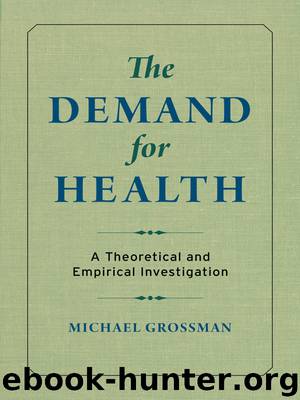Demand for Health by Michael Grossman

Author:Michael Grossman
Language: eng
Format: epub
Tags: BUS069030, Business & Economics/Economics/Theory, BUS023000, Business & Economics/Economic History
Publisher: Columbia University Press
Published: 2017-07-18T04:00:00+00:00
Obviously, Y1 = Y2 = Y3 for families with only one wage earner. In addition, note that Y4 does take account of net earnings lost by all family members.
The variables just described place an upper and lower limit on potential family income. The upper limit is given by Y3, the lower limit by Y1 or Y4, and a value that lies between these two extremes by Y2.23 Hopefully, the income elasticities computed with these four variables will bracket the true parameter.24
The regression equations fitted to the NORC data contain family income, an individual’s weekly wage rate, and his level of education as independent variables. Since Y, W, and E are all positively correlated, one might be puzzled at first by the interpretation to be given to the procedure of parceling out the separate effects of each via the multiple regression technique. Variations in property income could explain why two people with different full-time earnings have the same income. But how could two persons with the same amount of education have different wage rates when it is by this time well-accepted that an increase in education raises market productivity? Robert Michael has considered this question and has concluded that there are a variety of possible answers: “different relative degrees of labor shortage or abundance in different occupations, different degrees of monopoly power or of union strength, different innate ability, … different amounts of on-the-job training … or other forms of human capital, [and] luck.”25 Thus, it is possible at a conceptual level to raise W, Y, or E with the other two fixed. Of course, if these variables were subject to errors of measurement, their coefficients would be biased; the sources and directions of these biases are discussed in the second section of appendix D.
The last explanatory variable in the demand functions is family size (FS). This variable is included in the regressions for two reasons. First, the number of children in a family and the health stocks of its adult members might be complements. This is a plausible hypothesis because the lower the amount of sick time the more time there is available for childrearing activities. Second, since the dependent variables pertain to individuals and not families, per capita income might be a more appropriate measure of command over real resources than family income. This is easily accomplished if family income and family size enter the regressions.26
One final comment on the regression analysis is in order. Whites in the NORC sample reported more sick days than nonwhites, which contradicts data in the U.S. National Health Survey.27 Since there were few nonwhites in the sample, it was felt that the data for them might be unreliable. Consequently, it was decided to restrict the analysis to whites in the labor force. The sample size of this group is 1,770.
Download
This site does not store any files on its server. We only index and link to content provided by other sites. Please contact the content providers to delete copyright contents if any and email us, we'll remove relevant links or contents immediately.
Bullshit Jobs by David Graeber(4094)
Radical Candor by Kim Scott(2670)
I Am Right, You Are Wrong by Edward De Bono(2420)
23:27 by H. L. Roberts(2195)
Nomadland by Jessica Bruder(2014)
Average Is Over by Tyler Cowen(1805)
The Conflict Resolution Phrase Book by Barbara Mitchell & Cornelia Gamlem(1734)
Out of Our Minds: Learning to Be Creative by Ken Robinson(1691)
High-Impact Interview Questions by Victoria A. Hoevemeyer(1663)
Who Moved My Cheese?: An Amazing Way to Deal With Change in Your Work and in Your Life by Johnson Spencer(1615)
The Ideal Team Player by Patrick M. Lencioni(1608)
An Everyone Culture: Becoming a Deliberately Developmental Organization by Robert Kegan & Lisa Laskow Lahey(1599)
The Asshole Survival Guide by Robert I. Sutton(1559)
Automatic Society by Bernard Stiegler(1511)
Unleashed by Anne Morriss & Frances Frei(1492)
Who by Street Randy & Smart Geoff(1471)
42 Rules of Employee Engagement by Susan Stamm(1438)
96 Great Interview Questions to Ask Before You Hire by Paul Falcone(1400)
Fish! by Stephen C. Lundin(1346)
